Maryland in the American Civil War
During the American Civil War (1861–1865), Maryland, a slave state, was one of the border states, straddling the South and North. Despite some popular support for the cause of the Confederate States of America, Maryland would not secede during the Civil War. Because the state bordered the District of Columbia and the strong desire of the opposing factions within the state to sway public opinion towards their respective causes, Maryland played an important role in the war. Newly elected 16th President Abraham Lincoln (1809–1865, served 1861–1865), suspended the constitutional right of habeas corpus in Maryland; and he dismissed Chief Justice Roger B. Taney of the U.S. Supreme Court's "Ex parte Merryman" decision in 1861 concerning freeing John Merryman, a prominent Southern sympathizer from Baltimore County arrested by the military and held in Fort McHenry (then nicknamed the "Baltimore Bastille"). The Chief Justice, (but not in a decision with the other justices), had held that the suspension was unconstitutional and could only be done by Congress and would leave lasting civil and legal scars.[1] The decision was filed in the U.S. Circuit Court for Maryland by Chief Justice Roger Brooke Taney, a Marylander from Frederick (and sometimes in Baltimore) and former protege of seventh President Andrew Jackson who had appointed him two decades earlier.
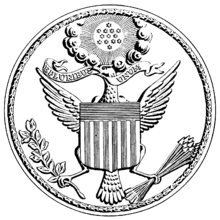 |
|
Union states in the American Civil War |
|---|
|
| Dual governments |
| Territories and D.C. |

The first fatalities of the war happened during the Baltimore Civil War Riots of Thursday/Friday, April 18-19, 1861, on the waterfront piers adjacent to Pratt and President Street, between the President Street Station and the Camden Street Station. A year and a half later, the single bloodiest day of combat in American military history occurred during the first major Confederate invasion of the North in the Maryland Campaign, just north above the Potomac River near Sharpsburg in Washington County, at the Battle of Antietam on September 17, 1862. Preceded by the pivotal skirmishes at three mountain passes of Crampton, Fox and Turner's Gaps to the east in the Battle of South Mountain, Antietam (also known in the South as the Battle of Sharpsburg), though tactically a draw, was strategically enough of a Union victory in the second year of the war to give 16th President Abraham Lincoln the opportunity to issue in September 1862, the Emancipation Proclamation, taking effect January 1, 1863, which declared slaves in the rebelling states of the Confederacy (but not those in the areas already occupied by the Union Army or in border slave states like Maryland, Delaware, Kentucky, and Missouri) to be "henceforth and forever free".
Later, in July 1864, the Battle of Monocacy near Frederick, Maryland in the third and last major Southern invasion, was also fought on Maryland soil. Monocacy was a tactical victory for the Confederate States Army but a strategic defeat, as the one-day delay inflicted on the attacking Confederates under Gen. Jubal Early by Federal General Lew Wallace's units hastily sent west on the Baltimore and Ohio Railroad with reinforcements from Baltimore with their stout resistance cost rebel General Early his chance to capture the Union capital of Washington, D.C. during the subsequent attack on the outlying northwestern fortifications near Fort Stevens, witnessed by President Lincoln himself in the only time that a Chief Executive came under hostile fire.
Across the state, some 50,000 citizens signed up for the military, with most joining the United States Army. Approximately a tenth as many enlisted to "go South" and fight for the Confederacy. The most prominent Maryland leaders and officers during the Civil War included Governor Thomas H. Hicks who, despite his early sympathies for the South, helped prevent the state from seceding, and Confederate Brigadier General George H. Steuart, who was a noted brigade commander under Robert E. Lee in the Army of Northern Virginia.
Abolition of slavery in the State of Maryland came before the end of the war, with a new third constitution voted approval in 1864 by a small majority of Radical Republican Unionists then controlling the nominally Democratic state. Animosity against Lincoln would remain, and Marylander John Wilkes Booth would assassinate President Lincoln on April 14, 1865, crying "sic semper tyrannis" the Virginia state motto as he did so in Washington's Ford's Theater, then fleeing and hiding in southern Maryland for a week hunted by Federal troops before slipping across the Potomac and later shot in a Virginia barn.
The approach of War
| History of Maryland |
|---|
|
|
|
Maryland's sympathies

Maryland, as a slave-holding border state, was deeply divided over the antebellum arguments over states' rights and the future of slavery in the Union.[2] Culturally, geographically and economically, Maryland found herself neither one thing nor another, a unique blend of Southern agrarianism and Northern mercantilism.[2] In the leadup to the American Civil War, it became clear that the state was bitterly divided in its sympathies. There was much less appetite for secession than elsewhere in the Southern States (South Carolina, Mississippi, Florida, Georgia, Alabama Louisiana, Texas, Virginia, North Carolina, Arkansas, Tennessee) or in the border states (Kentucky and Missouri),[3] but Maryland was equally unsympathetic towards the potentially abolitionist position of Republican candidate Abraham Lincoln. In the presidential election of 1860 Lincoln won just 2,294 votes out of a total of 92,421, only 2.5% of the votes cast, coming in at a distant fourth place with Southern Democrat (and later Confederate general) John C. Breckinridge winning the state.[1][4] In seven counties, Lincoln received not a single vote.[2]
The areas of Southern and Eastern Shore Maryland, especially those on the Chesapeake Bay (which neighbored Virginia), which had prospered on the tobacco trade and slave labor, were generally sympathetic to the South, while the central and western areas of the state, especially Marylanders of German origin,[5] had stronger economic ties to the North and thus were pro-Union.[6] Not all blacks in Maryland were slaves. The 1860 Federal Census[7] showed there were nearly as many free blacks (83,942) as slaves (87,189) in Maryland, although the latter were much more dominant in southern counties.
However, across the state, sympathies were mixed. Many Marylanders were simply pragmatic, recognizing that the state's long border with the Union state of Pennsylvania would be almost impossible to defend in the event of war. Maryland businessmen feared the likely loss of trade that would be caused by war and the strong possibility of a blockade of Baltimore's port by the Union Navy.[8] Other residents, and a majority of the legislature, wished to remain in the Union, but did not want to be involved in a war against their southern neighbors, and sought to prevent a military response by Lincoln to the South's secession.[9]
After John Brown's raid on Harpers Ferry in 1859, many citizens began forming local militias, determined to prevent a future slave uprising.
Baltimore Riot of 1861

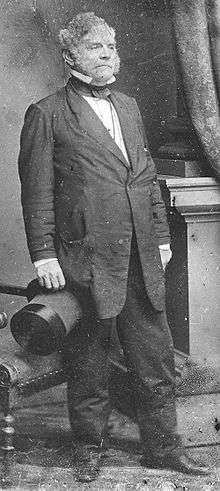
The first bloodshed of the Civil War occurred in Maryland. Anxious about the risk of secessionists capturing Washington, D.C., given that the capital was bordered by Virginia, and preparing for war with the South, the federal government requested armed volunteers to suppress "unlawful combinations" in the South.[10] Soldiers from Pennsylvania and Massachusetts were transported by rail to Baltimore, where they had to disembark, march through the city, and board another train to continue their journey south to Washington.[11]
As one Massachusetts regiment was transferred between stations on April 19, a mob of Marylanders sympathizing with the South, or objecting to the use of federal troops against the seceding states, attacked the train cars and blocked the route; some began throwing cobblestones and bricks at the troops, assaulting them with "shouts and stones".[12] Panicked by the situation, several soldiers fired into the mob, whether "accidentally", "in a desultory manner", or "by the command of the officers" is unclear.[12] Chaos ensued as a giant brawl began between fleeing soldiers, the violent mob, and the Baltimore police who tried to suppress the violence. Four soldiers and twelve civilians were killed in the riot.
The disorder inspired James Ryder Randall, a Marylander living in Louisiana, to write a poem which would be put to music and, in 1939, become the state song, "Maryland, My Maryland" (it remains the official state song to this day). The song's lyrics urged Marylanders to "spurn the Northern scum" and "burst the tyrant's chain" — in other words, to secede from the Union. Confederate States Army bands would later play the song after they crossed into Maryland territory during the Maryland Campaign in 1862.[13]
After the April 19 rioting, skirmishes continued in Baltimore for the next month. Mayor George William Brown and Maryland Governor Thomas Hicks implored President Lincoln to reroute troops around Baltimore city and through Annapolis to avoid further confrontations.[14] In a letter to President Lincoln, Mayor Brown wrote:
It is my solemn duty to inform you that it is not possible for more soldiers to pass through Baltimore unless they fight their way at every step. I therefore hope and trust and most earnestly request that no more troops be permitted or ordered by the Government to pass through the city. If they should attempt it, the responsibility for the bloodshed will not rest upon me.[14]
Hearing no immediate reply from Washington, on the evening of April 19 Governor Hicks and Mayor Brown ordered the destruction of railroad bridges leading into the city from the North, preventing further incursions by Union soldiers. The destruction was accomplished the next day.[15] One of the men involved in this destruction would be arrested for it in May without recourse to habeas corpus, leading to the ex parte Merryman ruling. For a time it looked as if Maryland was one provocation away from joining the rebels, but Lincoln moved swiftly to defuse the situation, promising that the troops were needed purely to defend Washington, not to attack the South.[16] President Lincoln also complied with the request to reroute troops to Annapolis, as the political situation in Baltimore remained highly volatile. Meanwhile, General Winfield Scott, who was in charge of military operations in Maryland indicated in correspondence with the head of Pennsylvania troops that the route through Baltimore would resume once sufficient troops were available to secure Baltimore.[17]
To secede or not to secede
Despite some popular support for the cause of the Confederate States of America, Maryland would not secede during the Civil War. However, a number of leading citizens, including physician and slaveholder Richard Sprigg Steuart, placed considerable pressure on Governor Hicks to summon the state Legislature to vote on secession, following Hicks to Annapolis with a number of fellow citizens:
to insist on his [Hicks] issuing his proclamation for the Legislature to convene, believing that this body (and not himself and his party) should decide the fate of our state...if the Governor and his party continued to refuse this demand that it would be necessary to depose him.[18]
Responding to pressure, on April 22 Governor Hicks finally announced that the state legislature would meet in a special session in Frederick, a strongly pro-Union town, rather than the state capital of Annapolis. The Maryland General Assembly convened in Frederick and unanimously adopted a measure stating that they would not commit the state to secession, explaining that they had "no constitutional authority to take such action,"[19] whatever their own personal feelings might have been.[20] On April 29, the Legislature voted decisively 53–13 against secession,[21][22] though they also voted not to reopen rail links with the North, and they requested that Lincoln remove Union troops from Maryland.[23] At this time the legislature seems to have wanted to avoid involvement in a war against its southern neighbors.[24]
Imposition of martial law

On May 13, 1861 General Benjamin F. Butler entered Baltimore by rail with 1,000 Federal soldiers and, under cover of a thunderstorm, quietly took possession of Federal Hill.[8] Butler fortified his position and trained his guns upon the city, threatening its destruction.[25] Butler then sent a letter to the commander of Fort McHenry:
I have taken possession of Baltimore. My troops are on Federal Hill, which I can hold with the aid of my artillery. If I am attacked to-night, please open upon Monument Square with your mortars.[26]
Butler went on to occupy Baltimore and declared martial law, ostensibly to prevent secession, although Maryland had voted solidly (53–13) against secession two weeks earlier,[27] but more immediately to allow war to be made on the South without hindrance from the state of Maryland,[25] which had also voted to close its rail lines to Northern troops, so as to avoid involvement in a war against its southern neighbors.[28] By May 21 there was no need to send further troops.[25] After the occupation of the city, Union troops were garrisoned throughout the state. By late summer Maryland was firmly in the hands of Union soldiers. Arrests of Confederate sympathizers and those critical of Lincoln and the war soon followed, and Steuart's brother, the militia general George H. Steuart, fled to Charlottesville, Virginia, after which much of his family's property was confiscated by the Federal Government.[29] Civil authority in Baltimore was swiftly withdrawn from all those who had not been steadfastly in favor of the Federal Government's emergency measures.[30]
During this period in spring 1861, Baltimore Mayor Brown,[31] the city council, the police commissioner, and the entire Board of Police, were arrested and imprisoned at Fort McHenry without charges.[1][32] One of those arrested was militia captain John Merryman, who was held without trial in defiance of a writ of habeas corpus on May 25, sparking the case of Ex parte Merryman, heard just 2 days later on May 27 and 28. In this case U.S. Supreme Court Chief Justice, and native Marylander, Roger B. Taney, acting as a federal circuit court judge, ruled that the arrest of Merryman was unconstitutional without Congressional authorization, which Lincoln could not then secure:
The President, under the Constitution and laws of the United States, cannot suspend the privilege of the writ of habeas corpus, nor authorize any military officer to do so.[33]
The Merryman decision created a sensation, but its immediate impact was rather limited, as the president simply ignored the ruling.[34] Indeed, when Lincoln's dismissal of Chief Justice Taney's ruling was criticized in a September 1861 editorial by Baltimore newspaper editor Frank Key Howard (Francis Scott Key's grandson), Howard was himself arrested by order of Lincoln's Secretary of State Seward and held without trial. Howard described these events in his 1863 book Fourteen Months in American Bastiles, where he noted that he was imprisoned in Fort McHenry, the same fort where the Star Spangled Banner had been waving "o'er the land of the free" in his grandfather's song.[35] Two of the publishers selling his book were then arrested.[1] In all nine newspapers were shut down in Maryland by the federal government, and a dozen newspaper owners and editors like Howard were imprisoned without charges.[1]
On September 17, 1861, the first day of the Maryland legislature's new session, fully one third of the members of the Maryland General Assembly were arrested, due to federal concerns that the Assembly "would aid the anticipated rebel invasion and would attempt to take the state out of the Union."[36] Although previous secession votes, in spring 1861, had failed by large margins,[22] there were legitimate concerns that the war-averse Assembly would further impede the federal government's use of Maryland infrastructure to wage war on the South.
One month later in October 1861 one John Murphy asked the United States Circuit Court for the District of Columbia to issue a writ of habeas corpus for his son, then in the United States Army, on the grounds that he was underage. When the writ was delivered to General Andrew Porter Provost Marshal of the District of Columbia he had both the lawyer delivering the writ and the United States Circuit Judge, Marylander William Matthew Merrick, who issued the writ, arrested to prevent them from proceeding in the case United States ex rel. Murphy v. Porter. Merrick's fellow judges took up the case and ordered General Porter to appear before them, but Lincoln's Secretary of State Seward prevented the federal marshal from delivering the court order.[37] The court objected that this disruption of its process was unconstitutional, but noted that it was powerless to enforce its prerogatives.[38][39]
The following month in November 1861, Judge Richard Bennett Carmichael, a presiding state circuit court judge in Maryland, was imprisoned without charge for releasing, due to his concern that arrests were arbitrary and civil liberties had been violated, many of the southern sympathizers seized in his jurisdiction. The order came again from Lincoln's Secretary of State Seward. The federal troops executing Judge Carmichael's arrest beat him unconscious in his courthouse while his court was in session, before dragging him out, initiating a public controversy.[40]
In another controversial arrest that fall, and in further defiance of Chief Justice Taney's ruling, a sitting U.S. Congressman Henry May (D-Maryland) was imprisoned without charge and without recourse to habeas corpus in Fort Lafayette.[41][42] May was eventually released and returned to his seat in Congress in December 1861, and in March 1862 he introduced a bill to Congress requiring the federal government to either indict by grand jury or release all other "political prisoners" still held without habeas.[43] The provisions of May's bill were included in the March 1863 Habeas Corpus Act, in which Congress finally authorized Lincoln to suspend habeas corpus, but required actual indictments for suspected traitors.[44]
Flight to Virginia
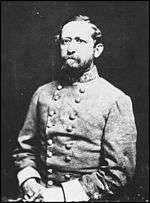
Many Marylanders sympathetic to the secession easily crossed the Potomac River into secessionist Virginia in order to join and fight for the Confederacy. During the early summer of 1861, several thousand Marylanders crossed the Potomac to join the Confederate Army. Most of the men enlisted into regiments from Virginia or the Carolinas, but six companies of Marylanders formed at Harpers Ferry into the Maryland Battalion.[45] Among them were members of the former volunteer militia unit, the Maryland Guard Battalion, initially formed in Baltimore in 1859.[46]
Maryland Exiles, including Arnold Elzey and brigadier general George H. Steuart, would organize a "Maryland Line" in the Army of Northern Virginia which eventually consisted of one infantry regiment, one infantry battalion, two cavalry battalions and four battalions of artillery. Most of these volunteers tended to hail from southern and eastern counties of the state, while northern and western Maryland furnished more volunteers for the Union armies.[47]
Captain Bradley T. Johnson refused the offer of the Virginians to join a Virginia Regiment, insisting that Maryland should be represented independently in the Confederate army.[45] It was agreed that Arnold Elzey, a seasoned career officer from Maryland, would command the 1st Maryland Regiment. His executive officer was the Marylander George H. Steuart, who would later be known as "Maryland Steuart" to distinguish him from his more famous cavalry colleague J.E.B. Stuart.[45]
The 1st Maryland Infantry Regiment was officially formed on June 16, 1861, and, on June 25, two additional companies joined the regiment in Winchester.[45] Its initial term of duty was for twelve months.[48]
It has been estimated that, of the state's 1860 population of 687,000, about 4,000 Marylanders traveled south to fight for the Confederacy. While the number of Marylanders in Confederate service is often reported as 20-25,000 based on an oral statement of General Cooper to General Trimble, other contemporary reports refute this number and offer more detailed estimates in the range of 3,500 (Livermore)[49] to just under 4,700 (McKim)[50], which latter number should be further reduced given that the 2nd Maryland Infantry raised in 1862 consisted largely of the same men who had served in the 1st Maryland, which mustered out after a year.
While other men born in Maryland may have served in other Confederate formations, the same is true of units in the service of the United States. The 1860 Census reported the chief destinations of internal immigrants from Maryland as Ohio and Pennsylvania, followed by Virginia and the District of Columbia. [51]
A similar situation existed in relation to Marylanders serving in the United States Colored Troops. Indeed, on the whole there appear to have been twice as many black Marylanders serving in the U.S.C.T. as white Marylanders in the Confederate army.[52]
Overall, the Official Records of the War Department credits Maryland with 33,995 white enlistments in volunteer regiments of the United States Army and 8,718 African American enlistments in the United States Colored Troops. A further 3,925 Marylanders, not differentiated by race, served as sailors or marines. [53] One notable Maryland front line regiment was the 2nd Maryland Infantry, which saw considerable combat action in the Union IX Corps. Another was the 4th United States Colored Troops, whose Sergeant Major, Christian Fleetwood was awarded the Medal of Honor for rallying the regiment and saving its colors in the successful assault on New Market Heights. [54]
A state divided
Not all those who sympathised with the rebels would abandon their homes and join the Confederacy. Some, like physician Richard Sprigg Steuart, remained in Maryland, offered covert support for the South, and refused to sign an oath of loyalty to the Union.[55] Later in 1861, Baltimore resident W W Glenn described Steuart as a fugitive from the authorities:
I was spending the evening out when a footstep approached my chair from behind and a hand was laid upon me. I turned and saw Dr. R. S. Steuart. He has been concealed for more than six months. His neighbors are so bitter against him that he dare not go home, and he committed himself so decidedly on the 19th April and is known to be so decided a Southerner, that it more than likely he would be thrown into a Fort. He goes about from place to place, sometimes staying in one county, sometimes in another and then passing a few days in the city. He never shows in the day time & is cautious who sees him at any time.[56]
Civil War
Battle of Front Royal
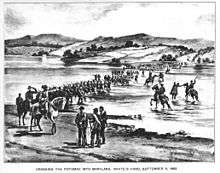
Because Maryland's sympathies were divided, many Marylanders would fight one another during the conflict. On May 23, 1862, at the Battle of Front Royal, the 1st Maryland Infantry, CSA was thrown into battle with their fellow Marylanders, the Union 1st Regiment Maryland Volunteer Infantry.[45] This is the only time in United States military history that two regiments of the same numerical designation and from the same state have engaged each other in battle.[57] After hours of desperate fighting the Southerners emerged victorious, despite an inferiority both of numbers and equipment.[57] When the prisoners were taken, many men recognized former friends and family. Major William Goldsborough, whose memoir The Maryland Line in the Confederate Army chronicled the story of the rebel Marylanders, wrote of the battle:
nearly all recognized old friends and acquaintances, whom they greeted cordially, and divided with them the rations which had just changed hands.[58]
Among the prisoners captured by William Goldsborough was his own brother Charles Goldsborough.[59]
On 6 September 1862 advancing Confederate soldiers entered Frederick, Maryland, the home of Colonel Bradley T. Johnson, who issued a proclamation calling upon his fellow Marylanders to join his colors. Disappointingly for the exiles, recruits did not flock to the Confederate banner. Whether this was due to local sympathy with the Union cause or the generally ragged state of the Confederate army, many of whom had no shoes, is not clear.[5] Frederick would later be extorted by Jubal Early, who threatened to burn down the city if its residents did not pay a ransom.[60] Hagerstown too would also suffer a similar fate.[61]
"Bloody Antietam"
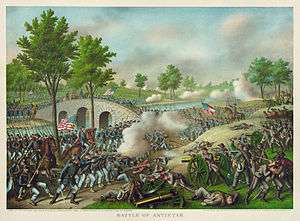
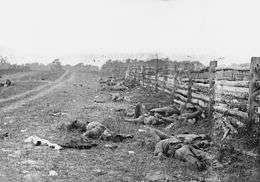
One of the bloodiest battles fought in the Civil war (and one of the most significant) was the Battle of Antietam, fought on September 17, 1862, near Sharpsburg, Maryland, in which Marylanders fought with distinction for both armies.[62] The battle was the culmination of Robert E. Lee's Maryland Campaign, which aimed to take the war to the North. Lee's Army of Northern Virginia, consisting of about 40,000 men, had entered Maryland following their recent victory at Second Bull Run.[63]
While Major General George B. McClellan's 87,000-man Army of the Potomac was moving to intercept Lee, a Union soldier discovered a mislaid copy of the detailed battle plans of Lee's army, on Sunday 14 September.[62] The order indicated that Lee had divided his army and dispersed portions geographically (to Harpers Ferry, West Virginia, and Hagerstown, Maryland), thus making each subject to isolation and defeat in detail - if McClellan could move quickly enough.[62] However, McClellan waited about 18 hours before deciding to take advantage of this intelligence and position his forces based on it, thus endangering a golden opportunity to defeat Lee decisively.[64]
The armies met near the town of Sharpsburg by the Antietam Creek. Losses were extremely heavy on both sides; The Union suffered 12,401 casualties with 2,108 dead. Confederate casualties were 10,318 with 1,546 dead. This represented 25% of the Federal force and 31% of the Confederate. More Americans died in battle on September 17, 1862, than on any other day in the nation's military history. The Confederate General A. P. Hill described
the most terrible slaughter that this war has yet witnessed. The broad surface of the Potomac was blue with floating bodies of our foe. But few escaped to tell the tale.[65]
Although tactically inconclusive, the Battle of Antietam is considered a strategic Union victory and an important turning point of the war, because it forced the end of Lee's invasion of the North, and it allowed President Lincoln to issue the Emancipation Proclamation, taking effect on January 1, 1863. Lincoln had wished to issue his proclamation earlier, but needed a military victory in order for his proclamation not to become self-defeating. As Lincoln himself stated, five days before the battle:
What good would a proclamation from me do.... I don't want to issue a document the whole world will see must be inoperative, like the Pope's Bull against a comet.[66]
Lee's setback at the Battle of Antietam can also be seen as a turning point in that it may have dissuaded the governments of France and Great Britain from recognizing the Confederacy, doubting the South's ability to maintain and win the war.[67]
March to Gettysburg
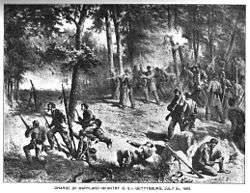
In June 1863 General Lee's army again advanced north into Maryland, taking the war into Union territory for the second time. Maryland exile George H. Steuart, leading the 2nd Maryland Infantry regiment, is said to have jumped down from his horse, kissed his native soil and stood on his head in jubilation. According to one of his aides: "We loved Maryland, we felt that she was in bondage against her will, and we burned with desire to have a part in liberating her".[68] Quartermaster John Howard recalled that Steuart performed "seventeen double somersaults" all the while whistling Maryland, My Maryland.[69] Such celebrations would prove short lived, as Steuart's brigade was soon to be severely damaged at the Battle of Gettysburg (July 1–3, 1863), a turning point in the war and a reverse from which the Confederate army would never recover.
Battle of Monocacy
In 1864, elements of the warring armies again met in Maryland, although this time the scope and size of the battle was much smaller. The Battle of Monocacy was fought on July 9, just outside Frederick, as part of the Valley Campaigns of 1864. Confederate forces under Lt. Gen. Jubal A. Early defeated Union troops under Maj. Gen. Lew Wallace. The battle was part of Early's raid through the Shenandoah Valley and into Maryland, attempting to divert Union forces away from Gen. Robert E. Lee's army under siege at Petersburg, Virginia. However, Wallace delayed Early for nearly a full day, buying enough time for Ulysses S. Grant to send reinforcements from the Army of the Potomac to the Washington defenses.
Prisoners of war
Thousands of Union troops were stationed in Charles County, and the Federal Government established a large, unsheltered prison camp at Point Lookout at Maryland's southern tip in St. Mary's County between the Potomac River and the Chesapeake Bay, where thousands of Confederates were kept, often in harsh conditions. Of the 50,000 Southern soldiers held in the army prison camp, who were housed in tents at the Point between 1863 and 1865, according to the Maryland Department of Natural Resources, (Maryland Park Service) nearly 4,000 died, although this death rate of 8 percent was less than half the death rate among soldiers who were still fighting in the field with their own armies.[70] The harshness of conditions at Point Lookout, and in particular whether such conditions formed part of a deliberate policy of "vindictive directives" from Washington, is a matter of some debate.[71]
The state capital Annapolis's western suburb of Parole became a camp where prisoners-of-war would await formal exchange in the early years of the war. Around 70,000 soldiers passed through Camp Parole until Lt. Gen. Ulysses S. Grant assumed command as General-in-Chief of the Union Army in 1864, and ended the system of prisoner exchanges.[72]
Slavery and emancipation
Those who voted for Maryland to remain in the Union did not at first contemplate the emancipation of Maryland's many slaves, or indeed those of the Confederacy. In March 1862 the Maryland Assembly passed a series of resolutions, stating that:
This war is prosecuted by the Nation with but one object, that, namely, of a restoration of the Union just as it was when the rebellion broke out. The rebellious States are to be brought back to their places in the Union, without change or diminution of their constitutional rights.[73]
In other words, as far as Marylanders were concerned, the war was being fought over Union, not over slavery. And, because Maryland had remained in the Union, the state was not included under the Emancipation Proclamation of January 1, 1863, which declared that all slaves within the Confederacy (but not those in border states like Maryland) would henceforth be free. It was not until 1864 that a constitutional convention was held which would address the issue of slavery in Maryland.
Constitution of 1864, and the abolition of slavery
The issue of slavery was finally confronted by the constitution which the state adopted in 1864. The document, which replaced the Maryland Constitution of 1851, was largely advocated by Unionists who had secured control of the state, and was framed by a Convention which met at Annapolis in April 1864.[74] Article 24 of the constitution at last outlawed the practice of slavery.
One feature of the new constitution was a highly restrictive oath of allegiance which was designed to reduce the influence of Southern sympathizers, and to prevent such individuals from holding public office of any kind.[74] The new constitution emancipated the state's slaves (who had not been freed by President Lincoln's Emancipation Proclamation), disenfranchised southern sympathizers, and re-apportioned the General Assembly based upon white inhabitants. This last provision diminished the power of the small counties where the majority of the state's large former slave population lived.
The constitution was submitted to the people for ratification on October 13, 1864 and it was narrowly approved by a vote of 30,174 to 29,799 (50.31% to 49.69%) in a referendum widely characterised by intimidation and fraud.[75] This was a controversial result, given the state's Confederate ties and sympathies. Those voting at their usual polling places were opposed to the Constitution by 29,536 to 27,541. However, the constitution secured ratification after Maryland's soldiers' votes were included in the count.[75] Marylanders serving in the Union Army were overwhelmingly in favor (2,633 to 263).[75] Maryland soldiers who were fighting for the Confederacy, and therefore could not vote, would likely have overwhelmingly opposed it.
The new constitution came into effect on November 1, 1864 and, while it emancipated the state's slaves, this did not mean equality for them, in part because the franchise continued to be restricted to white males. However, the abolition of slavery in Maryland did precede the Thirteenth Amendment to the United States Constitution, which outlawed slavery throughout the United States, and did not come into effect until December 6, 1865.
Emancipation did not immediately bring citizenship for former slaves. The Maryland legislature refused to ratify both the 14th Amendment, which conferred citizenship rights on former slaves, and the 15th Amendment, which gave the vote to African Americans.
The right to vote was eventually extended to non-white males in the Maryland Constitution of 1867, which remains in effect today. The Constitution of 1867 overturned the registry test oath embedded in the 1864 constitution.
Assassination of President Lincoln
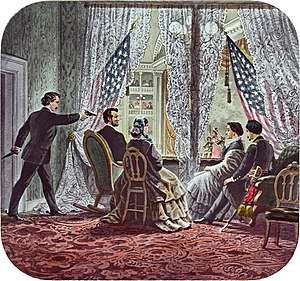
The issue of slavery may have been settled by the new constitution, and the legality of secession by the war, but this did not end the debate. On April 14, 1865 the actor John Wilkes Booth assassinated President Abraham Lincoln at Ford's Theatre in Washington, D.C. Booth was born in Harford County, Maryland, a northern county on the Pennsylvania border, which had few slaves.[76] After he shot Lincoln, Booth shouted "Sic semper tyrannis" ("Thus always to tyrants").[77] Other witnesses — including Booth himself — claimed that he only yelled "Sic semper!"[78][79] Some didn't recall hearing Booth shout anything in Latin. Some witnesses said he shouted "The South is avenged!"[80]:48 Others thought they heard him say "Revenge for the South!" or "The South shall be free!" Two said Booth yelled "I have done it!" After shooting the President, Booth galloped on his horse into Southern Maryland, where he was sheltered and helped by sympathetic residents and smuggled at night across the Potomac River into Virginia a week later.
In a letter explaining his actions, Booth wrote:
I have ever held the South was right. The very nomination of Abraham Lincoln, four years ago, spoke plainly war upon Southern rights and institutions... And looking upon African Slavery from the same stand-point held by the noble framers of our constitution, I for one, have ever considered it one of the greatest blessings (both for themselves and us,) that God has ever bestowed upon a favored nation… I have also studied hard to discover upon what grounds the right of a State to secede has been denied, when our very name, United States, and the Declaration of Independence, both provide for secession.[81]
Legacy
Most Marylanders fought for the Union, but after the war a number of memorials were erected in sympathy with the Lost Cause of the Confederacy, including in Baltimore a Confederate Women's Monument, and a Confederate Soldiers and Sailors Monument. Baltimore boasted a monument to Robert E. Lee and Stonewall Jackson[82] until they were taken down on August 16, 2017.[83] A home for retired Confederate soldiers in Pikesville, Maryland opened in 1888 and did not close until 1932. A brochure published by the home in the 1890s described it as:
a haven of rest... to which they may retire and find refuge, and, at the same time, lose none of their self-respect, nor suffer in the estimation of those whose experience in life is more fortunate.[84]
There is a Confederate monument behind the courthouse in Rockville, Maryland, dedicated to "the thin grey line".[85] Easton, Maryland also has a Confederate monument.[86] A statue of General Robert E. Lee in Baltimore was recently removed. Maryland has three chapters of the heritage group, Sons of Confederate Veterans.
War produced a legacy of bitter resentment in politics, with the Democrats being identified with "treason and rebellion", a point much pressed home by their opponents.[87] Democrats therefore re-branded themselves the "Democratic Conservative Party", and Republicans called themselves the "Union" party, in an attempt to distance themselves from their most radical elements during the war.[87]
The legacies of the debate over Lincoln's heavy-handed actions that were meant to keep Maryland within the union, such as arresting one third of the Maryland General Assembly, but were ruled unconstitutional at the time by Maryland native U.S. Supreme Court Chief Justice Roger Taney, and in the official lyrics of the still divisive Maryland state anthem, Maryland, My Maryland, which refers to Lincoln as a "despot," a "Vandal," and, the word Marylander John Wilkes Booth shouted when he assassinated Lincoln, a "tyrant."
See also
References
- Andrews, Matthew Page, History of Maryland, Doubleday, New York (1929)
- Arnett, Robert J., et al., Maryland: A New Guide to the Old Line State The Johns Hopkins University Press (1999)
- Davis, David Brion, Inhuman Bondage: The Rise and Fall of Slavery in the New World Retrieved January 2013
- Curry, Denis, C., "Native Maryland, 9000 B.C.–1600 A.D." (2001). Retrieved August 2012
- Gallagher, Gary W., Antietam: Essays on the 1862 Maryland Campaign, Kent State University Press (31 Dec 1992) Retrieved January 2013
- Gillipsie, James M., Andersonvilles Of The North: The Myths and Realities of Northern Treatment of Civil War Confederate Prisoners, University of North Texas Press (2011) Retrieved January 2013
- Goldsborough, W. W., The Maryland Line in the Confederate Army, Guggenheimer Weil & Co (1900), ISBN 0-913419-00-1.
- Harris, William C. (2011) Lincoln and the Border States: Preserving the Union. University Press of Kansas.
- Hein, David (editor),. Religion and Politics in Maryland on the Eve of the Civil War: The Letters of W. Wilkins Davis. 1988. Rev. ed., Eugene, OR: Wipf & Stock, 2009.
- Maryland State Archives (16 Sept. 2004).Historical Chronology Retrieved August 2012.
- Mitchell, Charles W., Maryland Voices of the Civil War. Retrieved August 2012
- Scharf, J. Thomas (1967 (reissue of 1879 ed.)). History of Maryland From the Earliest Period to the Present Day. 3. Hatboro, PA: Tradition Press
- Scharf, J. Thomas, History of Western Maryland: Being a History of Frederick, Montgomery, Carroll, Washington, Allegany, and Garrett Counties. (1882) Retrieved November 2012
- Tagg, Larry, The Generals of Gettysburg, Savas Publishing (1998), ISBN 1-882810-30-9.
- Whitman H. Ridgway. Maryland Humanities Council (2001). "(Maryland in) the Nineteenth Century". Retrieved August 2012
Notes
- Schoettler, Carl (November 27, 2001). "A time liberties weren't priority". The Baltimore Sun. Retrieved August 16, 2017.
- Mitchell, Charles (ed.). Maryland Voices of the Civil War. p. 3.
- Andrews, p506
- Andrews, p.505
- Andrews, p. 539
- Field, Ron, et al., p.33, The Confederate Army 1861–65: Missouri, Kentucky & Maryland Osprey Publishing (2008), Retrieved August 2012
- 1860 Census Information, U.S. Census Bureau
- Mitchell, p.12 Retrieved November 2012
- "Teaching American History in Maryland – Documents for the Classroom: Arrest of the Maryland Legislature, 1861". Maryland State Archives. 2005. Archived from the original on January 11, 2008. Retrieved February 6, 2008.
- Andrews, p.511
- Andrews, p.512
- Andrews, p.514
- Scharf, J. Thomas (1967) [1879]. "History of Maryland From the Earliest Period to the Present Day". 3. Hatboro, PA: Tradition Press: 494. Cite journal requires
|journal=(help) - Andrews, p.517
- Harris (2011) pp. 46-47
- Andrews, p.518
- Harris (2011) pp. 51-52. Harris states that Lincoln may or may not have been aware of this communication.
- Mitchell, p.71
- Scharf, p.202 Retrieved November 2012
- Andrews, p.520
- Mitchell, p.87
- Radcliffe, George Lovic-Pierce, Governor Thomas H. Hicks of Maryland and the Civil War, The Johns Hopkins Press, Nov-Dec 1901, pp. 73-74.
- "Teaching American History in Maryland – Documents for the Classroom: Arrest of the Maryland Legislature, 1861". Maryland State Archives. 2005. Archived from the original on January 11, 2008. Retrieved February 6, 2008.
- "Teaching American History in Maryland – Documents for the Classroom: Arrest of the Maryland Legislature, 1861". Maryland State Archives. 2005. Archived from the original on January 11, 2008. Retrieved February 6, 2008.
- Andrews, p.521
- Maryland Historical Society Retrieved February 2013
- "States Which Seceded". eHistory. Civil War Articles. Ohio State University. Archived from the original on October 6, 2014. Retrieved October 16, 2014.
- "Teaching American History in Maryland – Documents for the Classroom: Arrest of the Maryland Legislature, 1861". Maryland State Archives. 2005. Archived from the original on January 11, 2008. Retrieved February 6, 2008.
- Brugger, Robert J., Maryland, A Middle Temperament: 1634–1980. p.280 Retrieved Feb 28 2010
- Andrews, p.524
- Mitchell, p.207
- Mitchell, p.291 Retrieved November 2012
- Andrews, p.523
- Andrews, p.522
- Howard, F. K. (Frank Key) (1863). Fourteen Months in American Bastiles. London: H. F. Mackintosh. Retrieved August 18, 2014.
- William C. Harris, Lincoln and the Border States: Preserving the Union (University Press of Kansas, 2011) pp.71
- Inside Lincoln's White House: The Complete Civil War Diary of John Hay, p. 28 (SIU Press, Michael Burlingame and John R. Turner Ettlinger eds. 1999).
- 12 Stat. 762.
- "History of the Federal Judiciary: Circuit Court of the District of Columbia: Legislative History". Federal Judicial Center. Retrieved July 12, 2011.
- Scharf, J. Thomas. "Suspension of Civil Liberties in Maryland:". Maryland State Archives. Archived from the original on May 19, 2008. Retrieved May 16, 2008.
- The Bastille in America; or Democratic Absolutism. London: Robert Hardwicke, 1861, p. 12.
- Mitchell, Charles W., ed. Maryland Voices of the Civil War. JHU Press, 2007, p. 237.
- Jonathan White, "Abraham Lincoln and Treason in the Civil War: The Trials of John Merryman", LSU Press, 2011. p. 106
- Jonathan White, "Abraham Lincoln and Treason in the Civil War: The Trials of John Merryman", LSU Press, 2011. p. 107
- "2nd Maryland Infantry, CSA". Retrieved August 16, 2017.
- Field, Ron, et al., The Confederate Army 1861–65: Missouri, Kentucky & Maryland Osprey Publishing (2008), Retrieved March 4, 2010
- Andrews, p.543
- Andrews, p.544
- Thomas Livermore, Numbers and Losses in the Civil War, Boston, 1900. See chart and explanation, p. 550
- Randolph McKim, Numerical Strength of the Confederate Army, New York, 1912. See discussion and tabulation on pp. 62-65. Of the Trimble count, McKim states The estimate above alluded to, of 20,000 Marylanders in the Confederate service, rests apparently upon no better basis than an oral statement of General Cooper to General Trimble, in which he said he believed that the muster rolls would show that about 20,000 men in the Confederate army had given the State of Maryland as the place of their nativity. How many were citizens of Maryland when they enlisted does not appear. Obviously many natives of Maryland were doubtless in 1861 citizens of other States, and could not therefore be reckoned among the soldiers furnished by Maryland to the Confederate armies.
- Population of the United States in 1860, G.P.O. 1864. See Introduction, p. xxxiv
- See, e.g., C. R. Gibbs' Black, Copper, and Bright, Silver Spring, Maryland, 2002. This history of the 1st U.S.C.T., credited to the District of Columbia contains roster on pp. 228-259 listing more than 300 men born in Maryland. Similarly, Robert Beecham, in his memoir, As If It Were Glory, Lanham, Maryland, 1998, p. 166, says of the 23rd U.S.C.T. that "the 23rd was made up of men mostly from Washington and Baltimore" though the regiment was credited to the state of Virginia.
- The War of the Rebellion, Series III, Volume 4, pp. 69-70.
- William A. Dobak, Freedom by the Sword, Skyhorse Publishing, 2013
- Helsel, David S., p.19, Spring Grove State Hospital Retrieved February 26, 2010
- Mitchell, Charles W., p.285, Maryland Voices of the Civil War Retrieved February 26, 2010
- Andrews, p.531
- Goldsborough, J. J., p.58, The Maryland Line in the Confederate Army Retrieved May 13, 2010
- Goldsborough, W.W., Introduction, The Maryland Line in the Confederate Army, Butternut Press, Maryland (1983)
- Loewen, James W. (July 1, 2015). "Why do people believe myths about the Confederacy? Because our textbooks and monuments are wrong. False history marginalizes African Americans and makes us all dumber". The Washington Post. Retrieved March 10, 2016.
Confederate cavalry leader Jubal Early demanded and got $300,000 from them lest he burn their town, a sum equal to at least $5,000,000 today.
- "Hagerstown Herald and Torch Light". Western Maryland Historical Library. July 20, 1864. Retrieved January 1, 2014.
- Andrews, p.541
- Andrews, p.539
- McPherson, p. 109.
- Andrews, p.542
- Davis, p.313 Retrieved January 2013
- Gallagher, p.vii Retrieved January 2013
- Tagg, p.273
- Goldsborough, p.98.
- Point Lookout History, Maryland Department of Natural Resources Retrieved August 2012
- Gillipsie, p.179 Retrieved January 2013
- Arnett, p.81 Retrieved January 2013
- Andrews, p.527
- Andrews, p.553
- Andrews, p.554
- https://commons.wikimedia.org/wiki/File:MarylandSlavePop.jpg
- http://law2.umkc.edu/faculty/projects/ftrials/lincolnconspiracy/boothdiary.html
- Diary Entry of John Wilkes Booth Archived 2010-12-29 at the Wayback Machine
- "TimesMachine April 15, 1865 - New York Times". The New York Times.
- Swanson, James. Manhunt: The 12-Day Chase for Lincoln's Killer. Harper Collins, 2006. ISBN 978-0-06-051849-3
- "The murderer of Mr. Lincoln" (PDF). The New York Times. April 21, 1865.
- "Lee-Jackson Memorial" Smithsonian Art Inventories Catalog Retrieved May 2013
- Welsh, Sean; Campbell, Colin (August 16, 2017). "Confederate monuments taken down in Baltimore overnight". The Baltimore Sun. Retrieved August 16, 2017.
- Maryland Historical Society Retrieved January 2013
- www.waymarking.com Rockville Civil War Monument - Rockville, Maryland. Retrieved August 2012
- Campbell, Colin (May 16, 2016). "As Confederate symbols come down, 'Talbot Boys' statue withstands the controversy". The Baltimore Sun. Retrieved March 1, 2017 – via The Washington Post.
- Andrews, p.563
Further reading
- Baker, Jean H. The Politics of Continuity: Maryland Political Parties from 1858 to 1870 (Johns Hopkins UP, 1973) online.
- Fields, Barbara. Slavery and Freedom on the Middle Ground: Maryland During the Nineteenth Century (1987).
External links
| Wikimedia Commons has media related to Maryland in the American Civil War. |